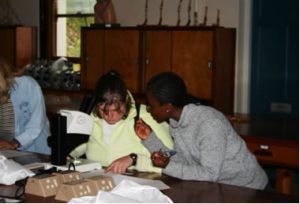Is it Linepithema humile or Tetramorium quadrispinosum? This was the question that teachers had to resolve during a recent visit to the Iimbovane laboratory. On Thursday, 02 July 2009, twenty-two science educators from various schools in the United States of America and South Africa visited the DST-NRF Centre of Excellence for Invasion Biology (C·I·B) as part of the Global Environmental Teachings (GET) Programme 2009. The group from the USA arrived in South Africa on 22 June 2009 to share ideas and learn from environmental education initiatives in South Africa.
 The afternoon kicked off with an information session on the Iimbovane Outreach Project, after which they were treated to a tour of the Iimbovane laboratory and witness the activities surrounding sample preparation, ant identification and specimen mounting. The laboratory tour was followed by a practical ant identification session facilitated by Iimbovane Technical Officer, Keafon Jumbam. The visitors were put through their paces, as they learned about basic ant morphology and characteristics, as well as identifying two different ants to species level.
The afternoon kicked off with an information session on the Iimbovane Outreach Project, after which they were treated to a tour of the Iimbovane laboratory and witness the activities surrounding sample preparation, ant identification and specimen mounting. The laboratory tour was followed by a practical ant identification session facilitated by Iimbovane Technical Officer, Keafon Jumbam. The visitors were put through their paces, as they learned about basic ant morphology and characteristics, as well as identifying two different ants to species level.
Educators felt that the project distinguished itself from other environmental education initiatives by combining outcome learning activities with scientific monitoring. One of the group members, Mr. Heinrich Adonis, is currently participating in the Iimbovane Outreach Project and was able to give the group more insight on how teachers experience the project.
As part of the programme, educators spent time in fynbos settings and also become familiar with the importance of ants in fynbos ecology. Visiting the Iimbovane laboratory and learning about the project showcased to them how ants can be useful for educators in the Western Cape to explain different concepts of biodiversity.
Throughout the past several years, the GET Programme aimed to “bring the world to the classroom” by helping educators to gain a different perspective on environmental, political and social issues from around the globe. During their travels the group had a chance to learn how educators elsewhere in the world interact and use their surrounding environment to advance environmental education.